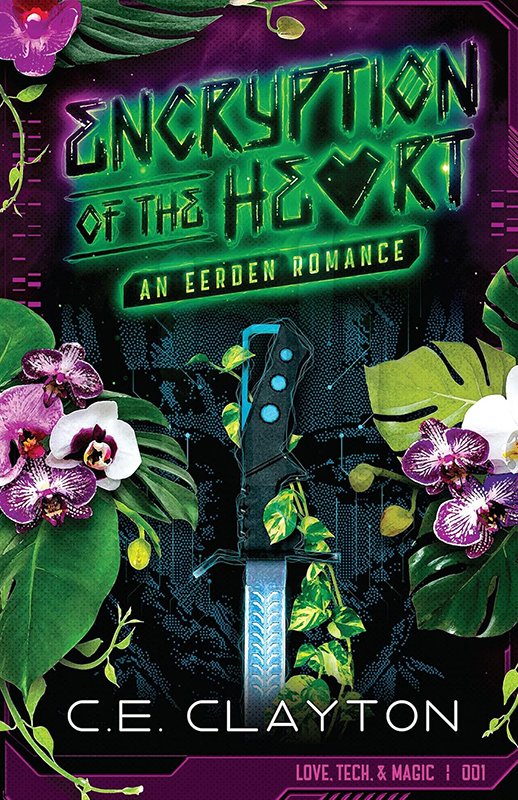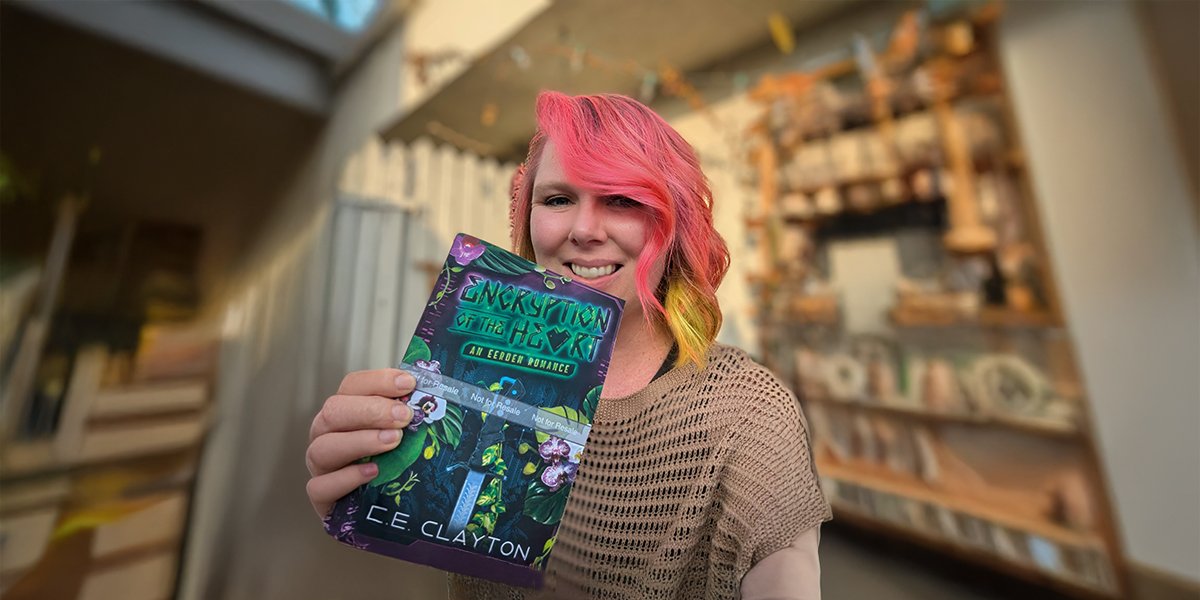PHOTO: Author C. E. Clayton, blending fantasy and science fiction with heart and grit, pictured with her beloved pets and signature tea in hand.
From Fantasy to Cyberpunk Futures
C. E. Clayton discusses her unique fusion of fantasy and cyberpunk, character development, horror elements, world-building methods, and how her academic background and life experiences shape her immersive storytelling.
C. E. Clayton is a name that fans of genre fiction should already have on their radar. With a rich bibliography spanning young adult fantasy, cyberpunk thrillers, and unsettling horror shorts, Clayton is not just a versatile storyteller—she’s a genre-bender with a knack for world-building that feels both immersive and refreshingly original. Her work explores the intersections of magic and machine, love and survival, identity and destiny, often through complex protagonists navigating layered, vividly imagined worlds.
In this interview with Reader’s House Magazine, Clayton opens up about her inspirations, from graphic novels and sci-fi epics to the realities of city life and academic studies in communication. She shares insight into her writing process, her character development arcs, and the delicate art of blending horror into fantasy. Whether you’re already a devoted reader of The Monster of Selkirk or just discovering the technomagic intrigue of her Eerden novels, Clayton’s passion for storytelling shines through every word.
C. E. Clayton is a master of crafting imaginative, genre-blending stories filled with rich worlds, emotional depth, and unforgettable characters.
What inspired you to blend cyberpunk elements with magic in your Eerden novels, such as ‘Resistor’?
I was heavily inspired by the creatures, technology, and space travel in the graphic novel “Saga”, the cyberpunk visuals and the morally questionable use of technology in “Altered Carbon”, and the seamless blending of magic and technology in “Arcane”. At the core of all these pieces of media, magic and technology hold hands. A futuristic world that still holds on to it’s glittering wonder thanks to magic? I just find that too inspiring to ignore!
How did your background in communication management influence your storytelling approach in ‘Encryption of the Heart’?
In a character driven romance like “Encryption of the Heart”, good and bad communication, and interpersonal relationship skills played a huge part to the storytelling. During my coursework, I learned about the verbal and nonverbal forms of communication people use to convey ideas, feelings, and important information both in business and in their lives. Communication management focuses on understanding how people communicate, the tools they use to communicate with, and the intricacies of interpersonal relationships, both platonic and romantic. I took that understanding and applied it to two very different people with very different understandings of their situation. Which created both tension, and romance as the characters better navigated their interpersonal relationships.
“Good and bad communication, and interpersonal relationship skills played a huge part to the storytelling.” – C. E. Clayton
Can you discuss the evolution of Tallis’s character throughout ‘The Monster of Selkirk’ series?
Tallis is my character that most closely follows the heroes’ journey. She occupies a unique space as a twist on the “chosen one” trope. At first, she doesn’t fit in anywhere, and is unwanted by her adopted father. She had to learn what she’s capable of, and when she discovers what that is, balancing the good person she is deep down with the terrible things she could do. She discovers her strength, then her control, and then chooses who she wants to be rather than what the prophecy dictates. It was a really fun evolution to explore because she goes from this lonely girl, to being told she’s this monster everyone should fear, suffers due to others choices, and rather than embracing her destiny to take revenge on those who made her life miserable, she chooses to save them and become a hero instead.
What challenges did you face when integrating horror elements into your fantasy narratives?
The biggest challenge is making sure those horror elements don’t overshadow the story. I add just enough of a creepy factor to a scene to add that sense of menace and danger for the main characters without the story veering into a cryptid type horror novel. To achieve that balance, I make sure those horror elements are few and far in between, just enough for atmosphere, and not enough for the monsters to steal the scene away from the plot or main characters.
How did your personal experiences shape the world-building in your recent works?
I was born and raised a city girl. I know what it’s like to live in a relatively small place crammed with people. I’ve seen the poverty and wealth stacked on top of each other, the crime that buts up against these glitzy restaurants and stores. I honestly love living in a city, but those zebra stripe extremes you get people and business wise when living in a city really inspired me.
What role does your involvement in the book community play in your writing process?
It helps me keep track of trends. The book community is very vocal about the kinds of characters, tropes and perspectives that they want to read about. Even if what they crave is a story I can’t tell, it lets me keep a mental tab open on what tropes and vibes I might include.
How do you balance writing complex characters with maintaining engaging plotlines in your novels?
World building. By crafting the world first, it alters how characters interact with not just other characters, but the situation—and therefore makes the plot more engaging with very grounded conflict. For example, in my Eerden novels, that world includes a sentient robotic race. One of my characters has a deep prejudice against those types of robots. So, whenever they travel to a place in the world where those sentient robots are, it alters how she behaves and responds, and how other characters respond to her in turn. The story still moves forward, but the tension from the character elevates the plotline, and also allows me to create complex characters that are very natural in that world and story.
What advice would you give to aspiring authors aiming to create immersive fantasy worlds?
Create a world bible where you lay out everything about your world free of your characters. How your world functions will shape how your characters behave and respond to challenges. Figure out the topography, religion, government, language, what technology people have, what resources etc., and keep that all separate from whatever you use to build your characters. Most fantasy worlds will span several books, so having something easy to go back to and look up details has been a life saver for me as my books have morphed into a shared universe. I personally love using World Anvil for my world bible and have used it for years now.
EDITOR’S CHOICE
A captivating blend of romance, magic, and tech with a fierce heroine and thrilling twists that keep you hooked throughout.



